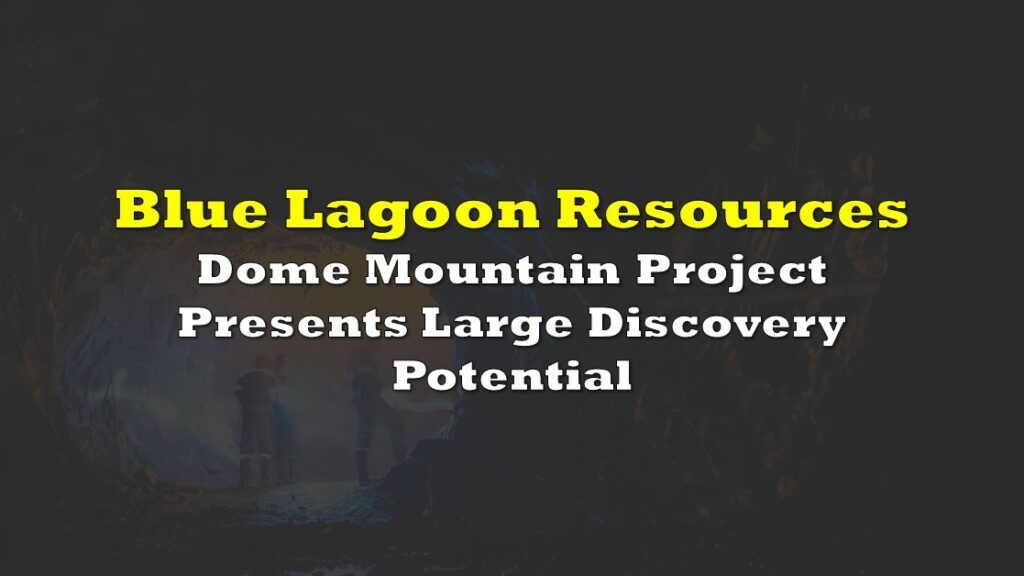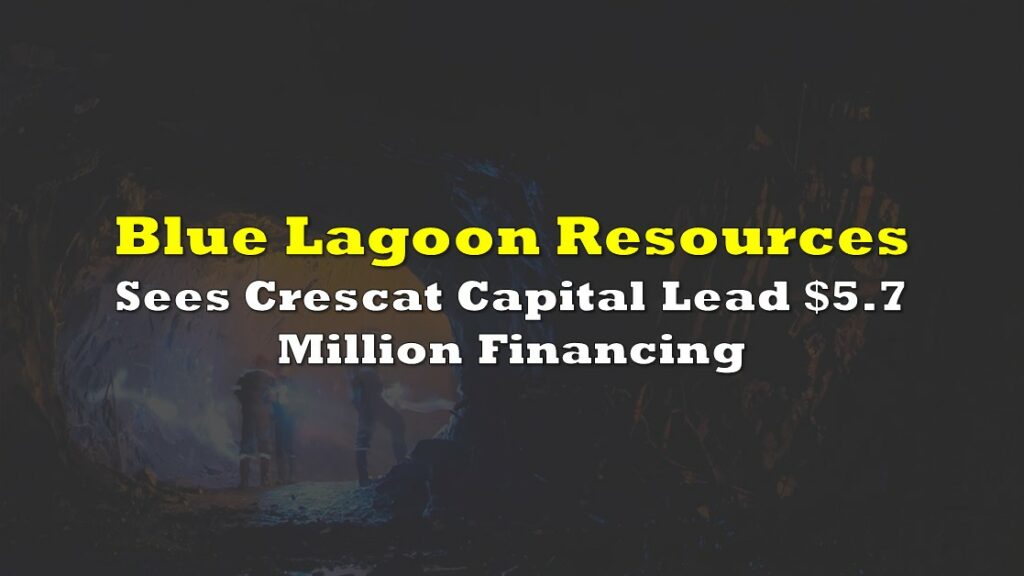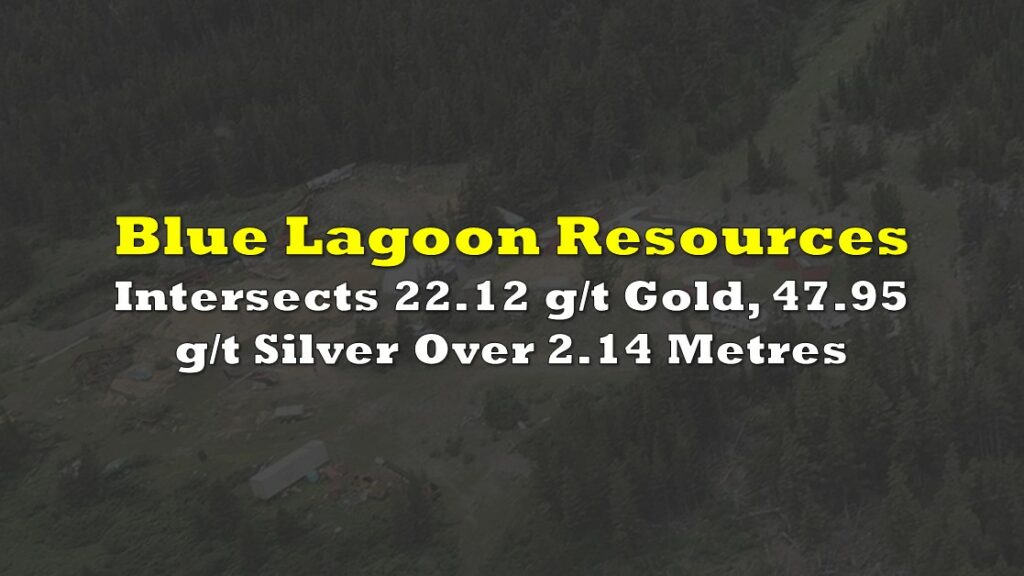Blue Lagoon Resources (CSE: BLLG), a junior exploration firm focused on its Dome Mountain gold project in British Columbia, was recently the topic of discussion in an interview with Quinton Hennigh. Hennigh, a renowned geologist, currently serves as the Geologic and Technical Director for Crescat Capital, an investment firm that has taken a sizeable stake in the firm.
The Dome Mountain property hosts the past-producing Dome Mountain gold mine and is host to 15 known high-grade gold veins, despite that 90% of the massive property being still unexplored. The project holds both an Environmental Management Act Permit as well as a Mining Permit providing for up to 75,000 tonnes of annual production. Blue Lagoon has been generating modest revenue from selling mineralized material from the mine, which helps to offset some of the Company’s operating costs while aggressively exploring the property’s many vein systems.
Hennigh’s recent discussion of the property follows an agreement signed in August 2021, whereby Hennigh agreed to provide his expertise on the exploration and development of Blue Lagoon’s property, while also providing geological and technical advice as the firm works to advance the project. Prior to Crescat’s participation, Dr. Hennigh had carefully looked at the potential of Dome Mountain and assessed that the project has much more discovery potential than just at the Boulder Vein, on which most of the historical drill programs were focused on.
In his view, the Dome Mountain project displays characteristics of a certain type of intermediate sulfidation system called a carbonate-base metal-gold deposit, similar to massive deposits found in various locations around the world. Low sulphide carbonate deposits were formed through volcanic activity from magmas that emitted carbon dioxide and are more alkaline in nature, as opposed to highly acidic, high sulphidation deposits created with high sulphur content. Volcanism forced the mineral-bearing fluids upwards to the earth’s surface where they cooled and the mineralization settled within shear zones, faults and breccias. At Dome Mountain these are appearing to be vertical formations that run deep, which is why multiple veins have been intercepted within the same drill holes.
One of the key drivers for the potential of Dome Mountain are its vein systems. Most drill holes have intercepted multiple veins, indicating that the rocks are widely interspersed with small high-grade mineralization which appears to be open at depth. While much of the property’s historical exploration was focused on the mineralized Boulder vein, Blue Lagoon recently completed a drill hole on a target structure to the northeast of the Boulder vein called the Chance Structural Corridor.
On February 7, the company announced that this drill hole encountered a new high-grade vein that returned assay values of 14.8 g/t gold and 38.3 g/t silver over 7.3 metres, as well as a second vein further downhole that returned 26.9 g/t gold and over 100 g/t silver over 1.04 metres. In all, this hole intersected four veins, and in Dr. Hennigh’s view, this constitutes a new discovery and further validates his hypothesis about the Dome Mountain geology.
Blue Lagoon is in the midst of a 20,000 metre drilling program with two drills now operating 24/7. The company will dedicate one of the drills to the Chance Structure to follow up on this latest development and the other drill will continue to follow up earlier holes with step-out and infill drilling to further delineate the size and scope of the vein systems emanating away from the Boulder Vein along strike and at depth.
| Hole ID | From (m) | To (m) | Interval (m) | Au g/t | Ag g/t |
| DM-21-244 | 186.92 | 187.63 | 0.71 | 7.46 | 10 |
| DM-21-244 | 247 | 247.8 | 0.8 | 6.89 | 25 |
| DM-21-244 | 381.2 | 388.51 | 7.31 | 14.8 | 38.3 |
| including | 381.2 | 381.6 | 0.4 | 47.3 | 87 |
| including | 383 | 384.1 | 1.1 | 62.6 | +100.00* |
| including | 387.93 | 388.51 | 0.58 | 31.5 | 58 |
| DM-21-244 | 443.52 | 444.56 | 1.04 | 26.9 | +100.00* |
Dr. Hennigh draws similarities of the Dome Mountain geology to that of the Buritica Gold Mine in Colombia, South America. Although the deposit’s footprint of 1.5 by 2.0 kilometres is smaller than Dome Mountain, there are many veins of high-grade mineralization that run vertically to depths of anywhere from 20 metres to 2,000 metres or more. Buritica, which is owned and operated by Xijin Mining of China, has reserves in excess of 10 million ounces of gold.
Other massive carbonate type gold deposits include:
- Porgera – Papua New Guinea – 30 million oz.
- Peñasquito Mine – Mexico 23 million oz.
- Acupan – Philippines 14 million oz.
- Fruta del Norte – Ecuador – 12 million oz.
- Blackwater – British Columbia- 12 million oz.
- Antamok – Philippines – 11 million oz.
- Hidden Valley – Papua New Guinea – 10 Million oz.
- Kelian – Indonesia – 8 million oz.
- Cowal – NSW, Australia 8 million oz.
What makes geologists such as Hennigh excited about the prospects for Dome Mountain is that it is a massive property of which 99% is still unexplored. Magnetic surveys indicate the potential for mineralization all over the property. “Crescat is very excited to help fund a very aggressive drill program at Dome Mountain this year, one that could result in the recognition of Dome Mountain as a potentially large, high-grade gold system,” commented Hennigh at the time of his initial involvement with the company last year.
FULL DISCLOSURE: Blue Lagoon Resources is a client of Canacom Group, the parent company of The Deep Dive. The author has been compensated to cover Blue Lagoon Resources on The Deep Dive, with The Deep Dive having full editorial control. Not a recommendation to buy or sell. We may buy or sell securities in the company at any time. Always do additional research and consult a professional before purchasing a security.









